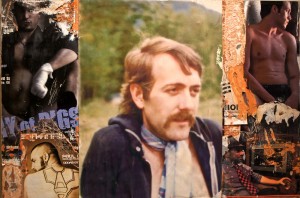In Now’s black waters burn the stars of Then @ Magnet
April 15, 2012
San Francisco, CA — For his first solo exhibition, In Now’s black waters burn the stars of Then visual artist Daniel Dallabrida approaches the modern gay era as timeless epic. He uses a sculptor’s hand to layer generations, memories, street imagery and ceramic onto wood panel. These works weave Dallabrida’s investigations into neo-medieval philosophy and influences of 20th-century Italian art with thirty-five years of queer and AIDS community activism.

On The Road With The Last God / Sulla strada con l’ultimo Dio (Memento Mori) 1982-2012
Décollage with artist’s archival images; ceramic on wood panel; 20 x 30 in.
During the month of March, Magnet, a pioneering gay men’s health center, presents Dallabrida’s series Memento Mori. In these works, Dallabrida appropriates the contemporary street advertising of queer dances, parties, bars and sex clubs. He layers these offerings of camp, beef, play and seduction over a substrata of unfired porcelain and pigment. He then shrouds these panels with personal photographs from iconic 1980s gay male gatherings. These tender portraits of earlier time offer an avid juxtaposition with the uber-urban homo reality of today. Finally, Dallabrida tears back through the layers to reveal a riveting queer gaze/gayz.
“I wanted to approach our era as a timeless epic,” says Dallabrida. “Epic time is not a linear construction. It is experienced as cycles of events that lay upon each other like stacks of parchment. Each parchment is a palimpsest from which older text had been scraped so as to be used again. The past, as part of the present, is never completely covered.”

Someone to Watch Over Me / Qualcono a vegliare su di me (Memento Mori), 1982- 2012
Street installation, San Francisco, Feb. 21, 2012.
Dallabrida’s site-specific exhibition at Magnet, as well as his street installations throughout the Castro, spans decades of gay history to present artifacts that provoke the telling of stories. He looks across and into the generational chasm carved by the AIDS crisis years (1985-1997). The intimate images from the artist’s personal archives capture friends and lovers, faeries and jocks in moments of intense, reflective observation. Deities and demigods, those depicted include both survivors and the fallen. And yet these past figures appear as contemporary as today’s young queer scruffs and jocks.
“When we hold onto the passage of time in a linear sense, we can be distracted from observation. We miss each other,” says Dallabrida. “Layering time allows us to see more commonalities than differences. Both sides can be valued. Both Now and Then are necessary for the definition of the present.”
On March 26, Dallabrida hosts a salon of pan-generational performance, poetry and video, Younger Than Jesus / Older Than AIDS, as part of the exhibition. This program looks into and across the generational chasm carved by the AIDS crisis years (1985-1997).

